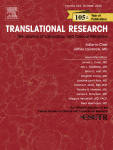|
Autores/as
Bobi, Joaquim; Garabito, Manel; Solanes, Núria; Cidad, Pilar; Ramos-Pérez, Víctor ; Ponce, Alberto ; Ponce, Alberto ; Rigol, Montserrat; Freixa, Xavier; Pérez-Martínez, Claudia; Pérez de Prado, Armando; Fernández-Vázquez, Felipe; Sabaté, Manel; Borrós, Salvador ; Rigol, Montserrat; Freixa, Xavier; Pérez-Martínez, Claudia; Pérez de Prado, Armando; Fernández-Vázquez, Felipe; Sabaté, Manel; Borrós, Salvador ; López-López, José Ramón; Pérez-García, Ma Teresa; Roqué, Mercè ; López-López, José Ramón; Pérez-García, Ma Teresa; Roqué, Mercè
|
Abstract
The modulation of voltage-gated K+ (Kv) channels, involved in cell proliferation, arises as a potential therapeutic approach for the prevention of intimal hyperplasia present in in-stent restenosis (ISR) and allograft vasculopathy (AV). We studied the effect of PAP-1, a selective blocker of Kv1.3 channels, on development of intimal hyperplasia in vitro and in vivo in 2 porcine models of vascular injury. In vitro phenotypic modulation of VSMCs was associated to an increased functional expression of Kv1.3 channels, and only selective Kv1.3 channel blockers were able to inhibit porcine VSMC proliferation. The therapeutic potential of PAP-1 was then evaluated in vivo in swine models of ISR and AV. At 15-days follow-up, morphometric analysis demonstrated a substantial reduction of luminal stenosis in the allografts treated with PAP-1 (autograft 2.72 ± 1.79 vs allograft 10.32 ± 1.92 vs allograft + polymer 13.54 ± 8.59 vs allograft + polymer + PAP-1 3.06 ± 1.08 % of luminal stenosis; P = 0.006) in the swine model of femoral artery transplant. In the pig model of coronary ISR, using a prototype of PAP-1-eluting stent, no differences were observed regarding % of stenosis compared to control stents (31 ± 13 % vs 37 ± 18%, respectively; P = 0.372) at 28-days follow-up. PAP-1 treatment was safe and did not impair vascular healing in terms of delayed endothelialization, inflammation or thrombosis. However, an incomplete release of PAP-1 from stents was documented. We conclude that the use of selective Kv1.3 blockers represents a promising therapeutic approach for the prevention of intimal hyperplasia in AV, although further studies to improve their delivery method are needed to elucidate its potential in ISR.
|

WoS
Scopus
Altmetrics
  
|
